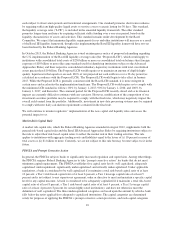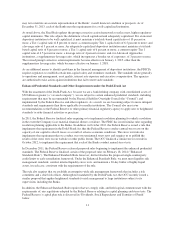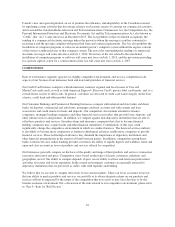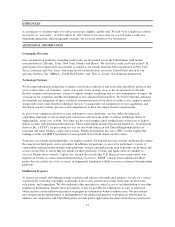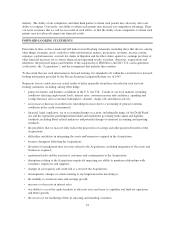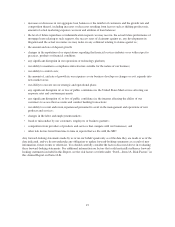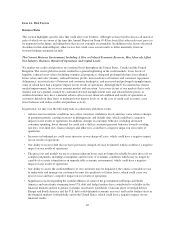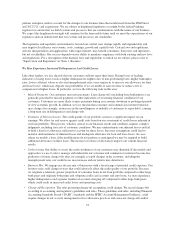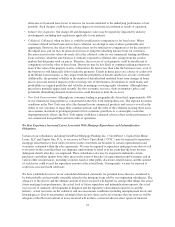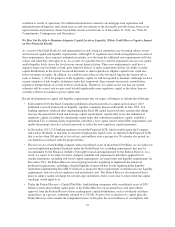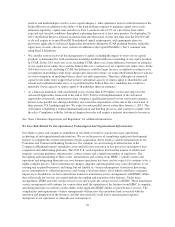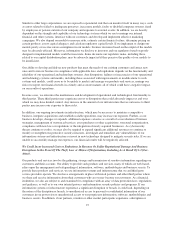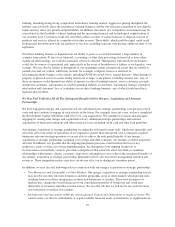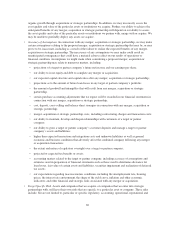Capital One 2013 Annual Report Download - page 40
Download and view the complete annual report
Please find page 40 of the 2013 Capital One annual report below. You can navigate through the pages in the report by either clicking on the pages listed below, or by using the keyword search tool below to find specific information within the annual report.Item 1A. Risk Factors
Business Risks
This section highlights specific risks that could affect our business. Although we have tried to discuss all material
risks of which we are aware at the time this Annual Report on Form 10-K has been filed, other risks may prove to
be important in the future, including those that are not currently ascertainable. In addition to the factors discussed
elsewhere in this Annual Report, other factors that could cause actual results to differ materially from our
forward looking statements include:
The Current Business Environment, Including A Slow or Delayed Economic Recovery, May Adversely Affect
Our Industry, Business, Results Of Operations And Capital Levels.
We market our credit card products on a national basis throughout the United States, Canada and the United
Kingdom. The recent global recession resulted in a general tightening in the credit markets, lower levels of
liquidity, reduced asset values (including commercial properties), sharp and prolonged declines in residential
home values and sales volumes, reduced business profits, increased rates of business and consumer repayment
delinquency, increased rates of business and consumer bankruptcy, and increased and prolonged unemployment,
some of which have had a negative impact on our results of operations. Although the U.S economy has shown
modest improvement, the recovery remains modest and uncertain. A recovery in any of our markets that is only
shallow and very gradual, marked by continued elevated unemployment rates and reduced home prices, or
another downturn, may have a material adverse effect on our financial condition and results of operations as
customers default on their loans or maintain lower deposit levels or, in the case of credit card accounts, carry
lower balances and reduce credit card purchase activity.
In particular, we may face the following risks in connection with these events:
• Adverse macroeconomic conditions may affect consumer confidence levels and may cause adverse changes
in payment patterns, causing increases in delinquencies and default rates, which could have a negative
impact on our results of operations. In addition, changes in consumer behavior, including decreased
consumer spending, lower demand for credit and a shift in consumer payment behavior towards avoiding
late fees, over-limit fees, finance charges and other fees, could have a negative impact on our results of
operations.
• Increases in bankruptcies could cause increases in our charge-off rates, which could have a negative impact
on our results of operations.
• Our ability to recover debt that we have previously charged-off may be limited, which could have a negative
impact on our results of operations.
• The processes and models we use to estimate inherent losses may no longer be reliable because they rely on
complex judgments, including assumptions and forecasts of economic conditions which may no longer be
capable of accurate estimation in an unpredictable economic environment, which could have a negative
impact on our results of operations.
• Our ability to assess the creditworthiness of our customers may be impaired if the criteria or models we use
to underwrite and manage our customers become less predictive of future losses, which could cause our
losses to rise and have a negative impact on our results of operations.
• Significant concern regarding the creditworthiness of some of the governments in Europe and South
America and uncertainty stemming from U.S. debt and budget matters have contributed to volatility in the
financial markets and led to greater economic uncertainty worldwide. Concerns about sovereign debt in
Europe and South America and the U.S. debt could diminish economic recovery and lead to further stress in
the financial markets, both globally and in the United States, which could have a negative impact on our
financial results.
20


